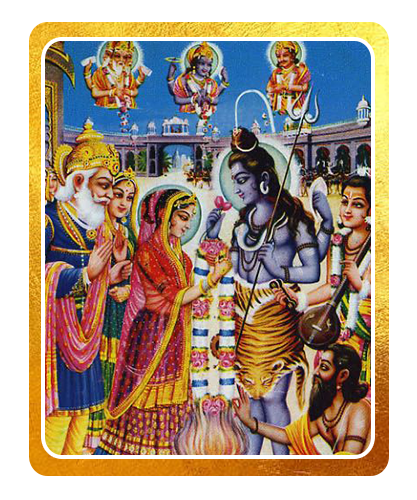USD 575.00
Scheduled Live Stream on November 24, 2023 @ 6 PM IST / 5:30 AM PST / 8:30 AM EST
Lord Shiva is considered a formless, unchanging, limitless, transcendent Brahman and the primal Atman (soul) of the universe.
The two facets of Lord Shiva are benevolent and fearsome. In the former, he is an omniscient yogi, a family man with a consort and two children, while in the latter, he slays demons and destroys evil. He is in total command of the cosmos and plays multiple roles as a creator, destroyer, and preserver. He protects his devotees from evil and blesses them with grace, knowledge, and peace.
He takes many forms to please his devotees when they face difficulties and suffering.
At Thirumanancheri, in Nagapattinam district of Tamil Nadu, Lord Shiva appeared as Kalyana Sundareswarar to remove delays and obstructions in marriage.
Invoking the lord solves all problems and gives immediate solutions to marital issues.
The earthly wedding of Lord Shiva and Goddess Parvati took place at Tirumanancheri, where Tirumana means marriage and Cheri means village.
Lord Shiva also blessed a prince who married a princess after their marriage came to a halt abruptly. Henceforth, the God earned the name Kalyana Sundareswarar.

Invoking Lord Kalyana Sundareswarar is a perfect solution to delayed marriages, divorce, and love incompatibilities. It resolves problems between couples and prevents divorce by solidifying relationships.
Invoking Lord Kalyana Sundareswarar is a perfect solution to delayed marriages, divorce, and love incompatibilities. It Those facing obstacles in marriage due to various reasons can also perform the Homam.
The ritual provides you with a perfect match and a happy married life. Even those with physical deformities can perform the ritual to find a suitable life partner.
Kalyana Sundareswarar Homam and Swayamvara Parvathi Homam will be performed on Pradosham, an auspicious time that is observed in the form of fasts and worship of Lord Shiva. Pra-dosh means the removal of sins. It occurs twice a month during Shukla Paksha and Krishna Paksha and is dedicated to the worship of Lord Shiva. Devotees are freed from the shackles of bondage and attain salvation. At twilight, between 4.30 and 6.00, people observe strict fasts, perform ceremonies to mitigate various problems, remove negative karma, and seek the immediate blessings of the lord.
The day coincides with Tulsi Vivah which is celebrated on the 12th day of Shukla paksha in the month of Kartik (mid-November- mid-December). The day signifies the beginning of the wedding season and the end of the monsoon season in some parts of the country.
Swayamvara Parvathi is the bridal form of Goddess Parvathi, the consort of Lord Shiva.
The form is a very enchanting one as it represents the state of Goddess Parvati’s lifetime longing to marry Lord Shiva. By performing rituals in the name of Lord Shiva and Goddess Parvathi, the lord removes all barriers that prevent relationships from happening, and the goddess symbolises good qualities associated with a wife. Goddess Parvati represents virtues such as fertility, marital bliss, proliferation, devotion to Her spouse, and asceticism.
Swayamvara Parvati Homam is a boon for removing obstacles that delay marriage. Goddess Parvati, the consort of Lord Shiva, also an embodiment of Shakti, is the main deity invoked in this Homa. The ritual removes blocks that prevent marriage, and the prospective bride or groom receives the blessings of a suitable spouse. It attracts the goddess towards you, Mama Vasam Akarsha, which means to get attracted to the person who is summoning the deity. It unites separated couples, removes infertility issues, and blesses them with prosperity and abundance, including child blessings.
The ritual has the power to strengthen relationships among all family members forever. By performing the ritual, a person can experience peace and harmony between lovers, married couples, and all other types of relationships within the family and friends.


Lord Shiva in this temple is self-manifested, and the temple is known as ‘Then Kayilayam’ or Southern Kailash. It is said that Amaraneethi Nayanar, one of the 63 Nayanmars, belonged to this place and attained salvation here. The uniqueness of this temple is that the Shiva Lingam changes its colour 5 times, and therefore, the lord is known as Sri Panchavarneswarar, where Pancha means five, Varnam means colour, and Eswarar means the lord.
Agastya Siddha consecrated another small lingam called Agastya lingam, besides the existing one, and worshipped it. Hence, there are two Lingams on a single base. Lord Shiva appeared before the Siddha in his wedding form in this temple. Also, Lord Brahma, Vishnu, and Shiva are present inside one sanctum which is another unique aspect of the temple. Smaller shrines include Utchistha Ganapathi, Dakshinamurthy, Lord Subramanya with his consorts, Ashta Bhuja Maha Kali Amman, etc. A puja in this temple eliminates sorrows, suffering, and diseases and grants blessings of wealth, prosperity, marriage, and child boons and fulfills wishes.

Swayamvara Parvati yantra denotes the Goddess Parvati. The person who worships the yantra attains the blessings of the mother for a happy and flourishing married life. For the unmarried, the yantra bestows a good life partner and removes obstacles in marriage and love relationships. The Yantra worship strengthens the bond between couples and paves the way for eternal happiness.
The yantra symbolises fertility, marital bliss, devotion to a spouse, asceticism, and power. Worshipping the yantra solves many problems related to marriage, conceiving, misunderstanding between couples, getting a spouse of one’s choice, and attracting a soul mate.
🎥https://www.youtube.com/watch?v=Mj0EZJcyNtY
Or
YouTube Video: